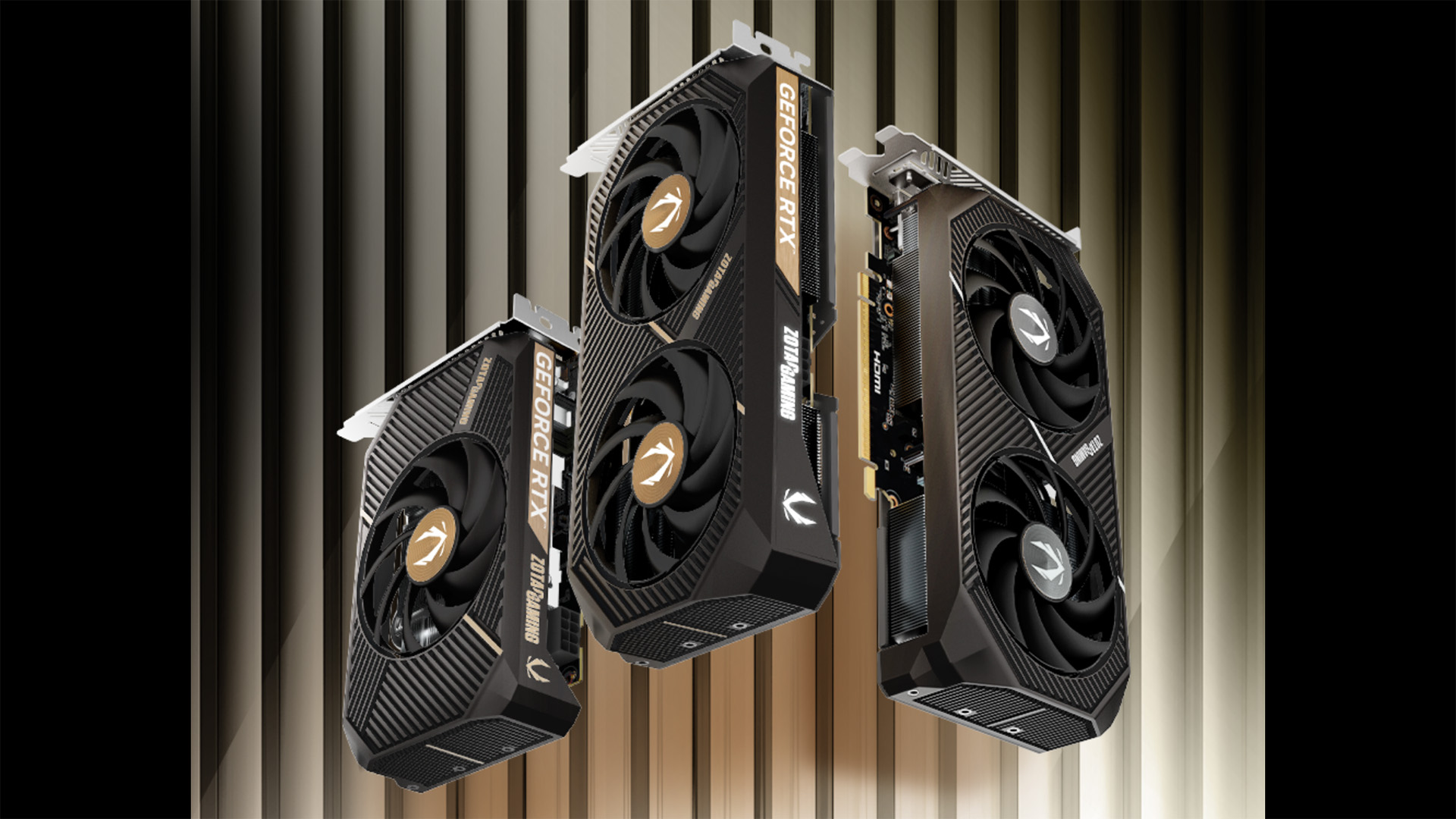Nvidia RTX 5060 Ti 8GB loses up to 10% performance when using PCIe 4.0
8GB VRAM no longer cuts it for modern gaming.

Nvidia launched the RTX 5060 Ti 16GB and 8GB models in mid-April, and the GPU with the larger VRAM received relatively positive reviews. However, many say that the 8GB graphics card is struggling due to a lack of VRAM, even at lower resolutions. Aside from that, Computer Base [machine translated] also discovered another issue brought by the smaller memory: reduced performance in some titles when attached to a PCIe 4.0 slot.
The publication measured 27 titles at 1440p, with the 8GB card getting an average FPS of 59.4 with a PCIe 5.0 motherboard, and a slightly lower 55.82 FPS when hooked up via PCIe 4.0. The 1% lows recorded are at 47.21 FPS and 43.93 FPS, respectively. This might not seem bad initially, but a few select titles had it much worse than the average.
Out of all the tested games, eight titles suffered a 5 FPS or more decrease in both average FPS and 1% lows—an almost 9% or more decrease in performance.
Game Title | RTX 5060 Ti 8GB, PCIe 5.0, FPS | RTX 5060 Ti 8GB, PCIe 4.0, FPS | FPS Difference | RTX 5060 Ti 8GB, PCIe 5.0, 1% Lows | RTX 5060 Ti 8GB, PCIe 4.0, 1% Lows | 1% Lows Difference |
|---|---|---|---|---|---|---|
Assassin's Creed Shadows | 54.9 | 54.4 | 0.5 | 50.9 | 49.5 | 1.4 |
Black Myth: Wukong | 60.7 | 60.7 | 0 | 50.7 | 50.3 | 0.4 |
COD: Black Ops 6 | 88.7 | 88.5 | 0.2 | 81.3 | 80.3 | 1 |
Dragon Age: The Veilguard | 34 | 4.8 | 29.2 | 24.6 | 3.3 | 21.3 |
Dragon's Dogma 2 | 63.3 | 63.2 | 0.1 | 56.5 | 55.8 | 0.7 |
Empire of the Ants | 75.7 | 75.7 | 0 | 64.8 | 64.7 | 0.1 |
F1 24 | 82 | 75.1 | 6.9 | 51.9 | 42.2 | 9.7 |
Final Fantasy XVI | 55.4 | 44 | 11.4 | 41.8 | 32.6 | 9.2 |
Frostpunk 2 | 61.7 | 61.6 | 0.1 | 48.5 | 48.1 | 0.4 |
Ghost of Tsushima | 56.9 | 55.8 | 1.1 | 53.1 | 51.4 | 1.7 |
God of War: Ragnarök | 65.3 | 65.1 | 0.2 | 54.8 | 54.6 | 0.2 |
Horizon Forbidden West | 50.5 | 45.1 | 5.4 | 44.5 | 39.4 | 5.1 |
Indiana Jones and the Big Circle | 40.5 | 28.3 | 12.2 | 27.8 | 22.8 | 5 |
Kingdom Come: Deliverance 2 | 67.2 | 67.1 | 0.1 | 59.4 | 59.3 | 0.1 |
Lego: Horizon Adventures | 57.9 | 57.4 | 0.5 | 51.1 | 50.8 | 0.3 |
MechWarrior 5: Clans | 44.5 | 41.6 | 2.9 | 32.7 | 30.7 | 2 |
Monster Hunter Wilds | 54.4 | 46.5 | 7.9 | 37 | 26 | 11 |
Oblivion Remastered | 35.5 | 33.2 | 2.3 | 15.5 | 13 | 2.5 |
Outcast: A New Beginning | 69.7 | 69.4 | 0.3 | 51.6 | 51.3 | 0.3 |
Satisfactory | 57.8 | 57.7 | 0.1 | 46.7 | 46.5 | 0.2 |
Senua's Saga: Hellblade 2 | 58 | 57.8 | 0.2 | 42.2 | 41.9 | 0.3 |
Silent Hill 2 | 62.7 | 61.7 | 1 | 41.8 | 40.8 | 1 |
Spider-Man 2 | 26.9 | 18.8 | 8.1 | 16.3 | 10.1 | 6.2 |
Stalker 2: Heart of Chernobyl | 77.3 | 76.8 | 0.5 | 61.2 | 61 | 0.2 |
Star Wars Outlaws | 58.9 | 58.7 | 0.2 | 48.1 | 47 | 1.1 |
The Last of Us Part II | 58 | 53 | 5 | 42.8 | 35.8 | 7 |
Warhammer 40k: Space Marine 2 | 85.4 | 85.1 | 0.3 | 77.2 | 76.8 | 0.4 |
Average | 59.40 | 55.82 | 3.58 | 47.21 | 43.93 | 3.29 |
This might not be an issue for enthusiasts with higher-end GPUs that cost more, as they most likely run the latest hardware or can afford to get them if needed. However, given that the RTX 5060 Ti 8GB is designed as a mainstream card, it will more likely be purchased by users running older motherboard models that might not have support for PCIe 5.0 yet. Of course, they’ll expect better performance when upgrading to this GPU, but if their favorite game happens to be one of the titles affected by this performance gap, they will be disappointed.
That’s why many reviewers no longer recommend graphics cards with 8GB of VRAM or less, especially if you’re a gamer. As PC game developers take advantage of more demanding hardware, players with GPUs with limited memory will tend to get left behind.
There might still be demand for a GPU at this price point, as Nvidia would likely not have made the 8GB variant if nobody would buy it. But if you want to make the most out of your money, you should stay away from brand-new graphics cards with less than 12GB of VRAM.
Follow Tom's Hardware on Google News to get our up-to-date news, analysis, and reviews in your feeds. Make sure to click the Follow button.
Get Tom's Hardware's best news and in-depth reviews, straight to your inbox.

Jowi Morales is a tech enthusiast with years of experience working in the industry. He’s been writing with several tech publications since 2021, where he’s been interested in tech hardware and consumer electronics.
-
ohio_buckeye Let’s be realistic. The 5060ti isn’t a terrible product itself for the right price. But 8gb vram on a gpu in 2025 is terrible for any card over $300. If there were a card in the class of a 1050ti which was $150 when it launched years ago then yes 8gb is fine. But not for $300-$400+ cards.Reply -
Alvar "Miles" Udell And why does this happen? Perhaps TomsHardware could try to replicate these results, and see if it also occurs across other RTX 5000 series products.Reply -
Notton If the GPU runs out of VRAM, it has to load from RAM or SSD.Reply
5060Ti has an 8x slot 5.0, so it has 32GB/s transfer speeds, and half that when PCIe4.0.
Where as the VRAM on the 5060Ti runs at 448GB/s. -
hotaru251 Reply
given the cost of extra 8gb its bad for anythign over 250.ohio_buckeye said:But 8gb vram on a gpu in 2025 is terrible for any card over $300. -
ohio_buckeye I actually have a 16gb 5060ti that I picked up for msrp and it’s a decent card but wouldn’t want to go with 8gb especially at about $400.Reply -
usertests Reply
Less VRAM means it needs to fetch data more frequently, using limited bandwidth. This was seen when comparing the 6500 XT 8GB and 4GB.wcbhkids said:8gb is not ideal but why does pcie4 matter? 5060 is unlikely to saturate PCIE
I saw some talk about Blackwell just being bad/buggy on PCIe 4.0. Maybe that's part of it. -
thestryker Reply
It's not this: I looked through their results which show PCIe 4.0 and 5.0 within margin of error on all of the tests where VRAM isn't an issue. The place where PCIe 4.0 vs 5.0 made a notable difference was in titles where the 8GB model was already behind the 16GB one. It definitely makes sense that this is where lower PCIe bandwidth would really show up.usertests said:I saw some talk about Blackwell just being bad/buggy on PCIe 4.0. Maybe that's part of it. -
razor512 Reply
When a game needs to use more than 8GB of VRAM, it will begin to allocate system memory. The speed of the PCIe bus impacts hoe much of a gradual performance drop you get, as well as impacts how much system memory you can allocate before the PCIe bus saturated and you end up with major issues with hitching and stuttering, or extremely low frame rates.wcbhkids said:8gb is not ideal but why does pcie4 matter? 5060 is unlikely to saturate PCIE
Since after the RTX 3000 series, Nvidia started leaning really hard into crippling the PCIe bus, we started seeing their cards struggle a lot more in those sub-optimal conditions.
While a different set of cards, when there is VRAM spillover, the RTX 3060 8GB has less of a performance hit than the 4060 8GB. While the spillover is never ideal, a faster PCIe interface makes a bad situation a little less bad (doesn't mean the situation becomes good, but it does become a bit less crappy).
If Nvidia is going to cripple the VRAM, then they should at least offer a full PCIe 5.0 X16 interface, which would go a long way to improving the ability to use shared memory.
The videocard drivers are smart enough to prioritize which memory pools are used, and do a decent job of moving assets that are less throughput intensive to the system memory, but as more gets moved over, the utilization adds up and once the PCIe bus saturates in at least one direction (typically when the bus usage hits 50%, since it doesn't read 100% unless you are simultaneously reading and writing as fast as possible), then games become unplayable..